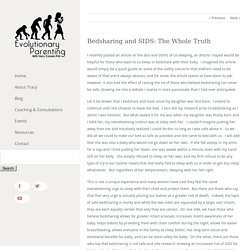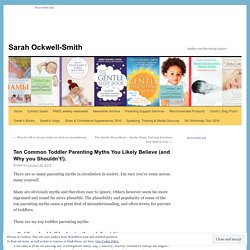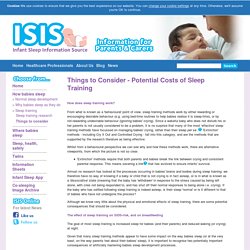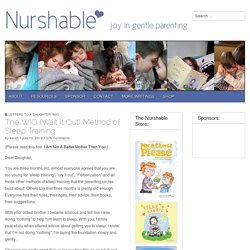

Bedsharing and SIDS: The Whole Truth. I recently posted an article on the do’s and don’ts of co-sleeping, an article I hoped would be helpful for those who want to co-sleep or bedshare with their baby.

I imagined the article would simply be a quick guide on some of the safety concerns that mothers need to be aware of that aren’t always obvious, and for some, the article seems to have done its job. However, it also had the effect of raising the ire of those who believe bedsharing can never be safe, drawing me into a debate I realize is more passionate than I had ever anticipated. Let it be known that I bedshare and have since my daughter was first born. I intend to continue until she chooses to leave the bed. I also did my research prior to bedsharing as I admit I was hesitant. This is not a unique experience and many women have said they feel the same overwhelming urge to sleep with their child and protect them. There’s a third red flag though, and one that is particularly salient. [Photo/Image credit: Gioia Albano] [2] [12] New Cry-It-Out Study Misses the Mark. A new study came out in the last few days, saying that cry-it-out is really just fine for babies…and maybe, it’s actually better.

Ten Common Toddler Parenting Myths You Likely Believe (and Why you Shouldn’t!... There are so many parenting myths in circulation in society.

I’m sure you’ve come across many yourself. Many are obviously myths and therefore easy to ignore. Others however seem far more ingrained and sound far more plausible. The plausibility and popularity of some of the top parenting myths cause a great deal of misunderstanding, and often stress, for parents of toddlers. These are my top toddler parenting myths: 1. You had a year of caring for a sleepless baby 24/7 surely, surely toddlers sleep all night? In addition to differing sleep cycles, a toddler’s sleep is dramatically different to that of an adult, composed of far more REM and less NREM sleep. 2. No, no they don’t. 3. Absolutely not true. 4. Educational toys, flashcards, learning to read apps and websites, foreign language DVDs. 5.
Society is barely tolerating of an attached baby, but a toddler who’s attached? 6. Breastfeeding is not just about food though, it is a wonderful comfort to a child. 7. All toddlers tantrum. This Is Why Your Baby Doesn't Sleep Through The Night. What the Heck Goes Wrong Sleep Wise at 8-10 Months? One of the most popular blog posts I’ve ever written is all about the 4-5 month sleep regression.

I need to make a confession, I lied a little bit in it. I gave the impression that things get a lot better after six months. And they do. Often though the improvement is only temporary and things can often get a lot, lot worse towards the end of the first year. Once again it is transient, things will get better. When parents are deep in the depths of the 4-5month sleep regression the very last thing they want to hear is that things will get better, but only for a couple of months when they get much worse. So what the heck happens to sleep between eight and ten months of age? Research has shown us that at nine months of age, getting on for two thirds of babies are waking regularly at night, that’s almost twenty percent more than those who wake regularly at six months. The problem with this is that this is unexpected.
Pinky McKay Official Website The myth of baby sleep regressions - what's really happening to your baby's sleep? - Pinky McKay Official Website. The 4 month sleep regression, the 12 month sleep regression, the 18 month sleep regression – what is happening?

Why it’s OK to let your baby or child cry (sometimes). If you follow attachment or gentle parenting principles, you should never willingly let your child cry, right?

Wrong. If you follow attachment or gentle parenting principles, you should never willingly make your child cry, right? You can very much be an attachment or gentle parent and both allow your child to cry and (shock horror) make them cry. In addition it’s very normal – and pretty common – to be either an attachment, or gentle, parent and have a child who cries, sometimes a lot. The Goal of Attachment or Gentle Parenting The goal of attachment parenting is to foster the attachment between child and caregiver. The goal of gentle parenting is to be mindful of the biological and psychological limitations of a child’s behaviour, to be respectful of the child and empathic towards them.
In essence, both are pretty similar in all but name. HPs_Guide_to_Coping_At_Night_Final. ISIS : Things to Consider - Potential Costs of Sleep Training - ISIS Online. How does sleep training work?

From what is known as a 'behavioural' point of view, sleep training methods work by either rewarding or encouraging desirable behaviour (e.g. using bed-time routines to help babies realise it is sleep-time), or by not-rewarding undesirable behaviour (ignoring babies' crying). Since a wakeful baby who does not disturb his or her parents is not usually considered to be a problem, it is no surprise that many of the most 'effective' sleep training methods have focussed on managing babies' crying, rather than their sleep per se .?
'Extinction' methods - including Cry It Out and Controlled Crying - fall into this category, and are the methods that are supported by the research literature as being effective. Whilst from a behavioural perspective we can see why and how these methods work, there are alternative viewpoints, from which the picture is not so clear. Cry It Out - 6 Educated Professionals Who Advise Against It. If you’re a parent, you’ve probably heard about the cry it out method to get your baby to sleep.

Well-meaning family or friends might suggest letting your baby cry himself to sleep, so he can ‘learn to be independent’. Or perhaps they suggest ‘cry it out’ because they say, ‘it works’. However, parenting techniques like ‘cry it out’, which originated in 1913 (and potentially earlier), aren’t always best. And when we know better, we do better. What some people believe ‘works’ on babies, actually has effects that go beyond their own understanding of the infant brain. In order to understand what cry it out really does to the infant brain, and why highly educated and trained professionals refuse to support it, I interviewed some leading experts in the baby sleep world.
The WIO (Wait It Out) Method of Sleep Training. (Please read this first: I Am Not A Better Mother Than You.)

Dear Daughter, You are three months old, almost everyone agrees that you are too young for “sleep training”, “cry it out”, “Ferberization” and all those other methods of sleep training that the parenting circles buzz about. Others say that three months is plenty old enough. Everyone has their rules, their ages, their advice, their books, their suggestions.